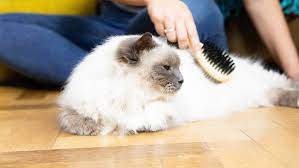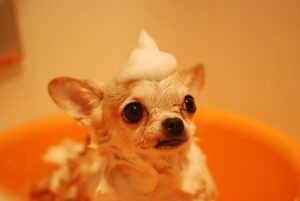
Coat Renewal In Cats
Cat shedding is a natural process. With the arrival of spring and autumn, cats renew their coats and their old hair falls out naturally.
What is the use of cat moulting?
The majority of cats indeed change their coat when the good weather arrives (at the beginning of spring): this moult allows them to adapt and withstand warmer temperatures more easily, thanks to lighter hair. With the onset of cold weather in the fall, cats moult again: their hair thickens to better protect them against falling temperatures.This renewal of the coat allows the cat to adapt to new climatic conditions but also to variations in daily sunshine (the photoperiod).
Cats, unequal in the face of moulting
As explained above, cats change their coat to adapt to the temperature of their environment: twice a year, it becomes thicker or lighter.In domestic indoor cats (those that live indoors, without access to a garden), shedding may be less severe. The heating and air conditioning systems indeed maintain a constant ambient temperature and the cat becomes less sensitive to temperature variations between each season.
In long-haired cats, the process of hair change is particularly important. But some short-haired cats can also lose a lot of hair during moulting periods!
Also read https://tekarticle.com
tekarticle.com/importance-of-contractor-table-saw-in-household-projects/
Environmental factors that can cause hair loss in cats
Putting aside the natural renewal of the coat during moulting, hair loss in cats can be caused by several external factors and different pathologies.
1. Stress
Cats are very sensitive to changes in their environment, unusual noises or possible new threats. Stress is one of the main causes of hair loss in cats. However, the majority of factors that can cause stress in cats come from its direct environment. In addition to causing a change in behaviour in cats, these triggers can have a real impact on their health.
The cat can be easily stressed by an external element, which seems to be able to threaten its bearings and its resources: another cat which enters its litter to make its needs there, the arrival of a new baby in the family, the reception of a dog at home or the presence of workers who have come to do work in the accommodation. Certain intense and repeated noises can also stress the cat (work in the street, particularly noisy neighbours, etc.).
As with humans, stress can affect the cat’s immune system: this can have the effect of weakening it and making it more susceptible to certain diseases. The stressed cat can therefore easily lose its hair. For example, he may suffer from hair loss on his stomach, inside his legs or on his tail.
2. Poor diet
Cat hair is 99% protein. Diets rich in high quality protein therefore naturally tend to strengthen the cat’s coat and prevent hair loss. Opting for a quality diet therefore helps to fight against hair loss in cats.Nevertheless, to be sure to offer your cat a balanced and adapted diet, you must not forget that not all proteins are created equal (indeed, they are not all of the same quality). Not all proteins prevent hair loss in cats. Indeed, some proteins display a high biological value (and a high bioavailability), while others are of poor quality. Your veterinarian can help you choose the best foods for your cat.
3. Allergies
Like their owners, cats can suffer from allergies. Most allergies are expressed by the appearance of skin reactions. So, if you notice your cat losing hair outside of moulting periods (usually between winter and spring, and just before fall) and the hair loss doesn’t seem to be caused by any other environmental factor, it may be a symptom of an allergy. Food allergies can cause localised alopecia in cats. They can also be the cause of the appearance of patches or skin redness. Treating these allergies often involves modifying your cat’s diet (by excluding certain foods or ingredients). The Nutro GRAIN FREE range is specially designed for this purpose. Without cereals or other allergenic components, without artificial ingredients or GMOs, the food offers the best nutritional intake while protecting your cat from problems related to its food sensitivity.
An itch can also cause hair loss in cats. A chronic inflammatory disease of the skin, atopic dermatitis is due to a hereditary predisposition to allergies. It can cause violent itching in cats, redness and hair loss. To treat this condition, you must first find the responsible allergen. For this, you can approach your veterinarian.
Diseases that cause hair loss in cats
The cat can also be the victim of a skin disease, which can cause a change in the cat’s coat.Although there are a wide variety of diseases and conditions that can cause hair loss in cats, the most common is ringworm. Ringworm (a fungus that feeds on the keratin of the hair) is manifested by the appearance of red eruptions on the cat’s skin. The cat can then be a victim of hair loss in patches.
Among the dermatological disorders that a cat can suffer from, some can be caused by bacteria, fungi or parasites. Some mites can for example cause intense itching in cats. If they settle in the cat’s coat, fleas can also cause them to scratch all day. If in doubt, it is recommended to consult a veterinarian.
Fight against cat hair loss
To fight against hair loss, you can start by identifying the origin of the problem: is he losing his hair because he is shedding? Do you suspect him of being stressed? Do you think he has developed a food allergy? If in doubt, contact your veterinarian.Brushing your cat regularly will also allow you to limit the fall of its hair during periods of moulting. If you want to learn more and learn how to control hair loss in your cat, you can download our free ebook. Click on the image and declare war on cat hair.








